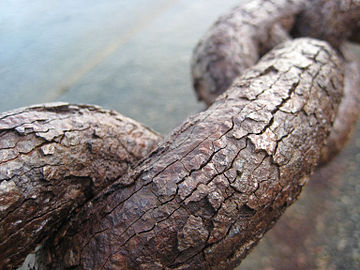Did you know?
You can double click on a word to look it up on TermGallery.
You can double click on a word to look it up on TermGallery.
Meanings of redox reaction in English
Russian
восстановители Portuguese
reacções de oxirredução Catalan
reacció d'oxidació-reducció Spanish
reacción redox 
Chemical reaction involving reduction and oxidation of different species.
Synonyms
Examples for "redox"
Examples for "redox"
1
However, the identity of most redox-regulated mitochondrial proteins remains to be defined.
2
This process obviates the need for exogenous enzymes and redox mediator supplements.
3
These findings reveal a new layer of nitroso-redox imbalance in dystrophic cardiomyopathy.
4
These single-domain flavoenzymes display redox potentials compatible with electron transfer between partners.
5
Hence, there is interest in redox and metabolic modulators as anticancer agents.
1
Their versatility, which arises from an ability to undergo reduction-oxidation chemistry, enables them to act as critical cofactors of enzymes throughout the cell.
2
Reactive oxygen species, generated by reduction-oxidation (redox) reactions, have been recognized as one of the major mediators of ischemia and reperfusion injury in the brain.
3
Reduction-oxidation (redox) signaling systems are emerging as important targets in pancreatic cancer.
1
Iron-sulfur clusters are prosthetic groups commonly found in proteins that participate in oxidation-reduction reactions and catalysis.
2
The N-terminus of MTRR containing a conserved domain of FMNRed is closely concerned with the oxidation-reduction process.
3
The mutated proteins show spectral properties similar to those of the wild-type enzyme, in all oxidation-reduction states.
4
This is in accord with the high oxidation-reduction potential of the flavin, which thermodynamically stabilizes the reduced enzyme.
5
In comparison, 27 proteins were up-regulated in dark-cutting beef related to oxidation-reduction processes, muscle contraction, and oxidative phosphorylation.
Usage of redox reaction in English
1
This cyclic redox reaction of the metal generates OH.
2
Taken together these data demonstrate that H296 is responsible for proton exchange in the redox reaction.
3
Flavin-based electron-bifurcation is a mechanism that couples an exergonic redox reaction to an endergonic one allowing energy conservation in anaerobic microorganisms.
4
This provides mass spectrometric evidence for the mechanism of the nitro to amine conversion process during nitroreduction, an important redox reaction involved in carcinogenesis.
5
Re-evaluating these previous data we here discuss a mechanism, by which the redox reaction of N2 induces conformational changes possibly leading to proton translocation.
6
We also discuss higher harmonics included in a limit cycle describing the isolated oscillator, dependence on the redox reaction, and hysteresis due to a bistability.
7
The opposite reaction was also observed on the same charged surface during a simulation of duration about 10 ps; it is a reversible redox reaction.
8
Flavoproteins participate in a wide variety of physiologically relevant processes that typically involve redox reactions.
9
Copper-dependent enzymes mediate electron transfer and other redox reactions.
10
Diet constituents can modulate redox reactions and the oxidative stress extent, thus also acting on nuclear gene expression.
11
These abnormal ligand-manipulated redox reactions may provide more possibilities for the chemical transformation of existing nanostructures into more complex ones.
12
Redox reactions go beyond what is commonly described as oxidative stress and involve redox mechanisms linked to signaling and metabolism.
13
The structural and biophysical results are discussed in relation to possible roles of Miner1 in cellular Fe-S management and redox reactions.
14
Meromictic lakes are useful biogeochemical models because of their stratified chemical gradients and separation of redox reactions down the water column.
15
NAD plays critical roles in cellular redox reactions and remains at a sufficient level in the cell to prevent cell death.
16
Recent studies have uncovered the diverse nature by which redox reactions and homeostasis contribute to brain physiology, and when dysregulated to pathological consequences.
Translations for redox reaction
Russian
Portuguese
Catalan

